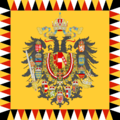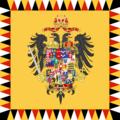Austro-Hungarian Empire
Austro Hungarian Empire Österreichisch-Ungarisches Reich (German) | |
|---|---|
| Motto: Indivisibiliter ac inseparabiliter | |
| Capital | Vienna |
| Largest city | Vienna, Budapest |
| Official languages | German, Hungarian |
| Recognised regional languages | Italian, Romanian, Czech, Slovak, Polish, Croatian, Slovenian, Bosnian, Serbian |
| Religion | Catholicism |
| Demonym(s) | Austro Hungarian |
| Government | Constitutional Monarchy |
• Kaiser | Vittorio I of Umbria |
• Kanzler | Vittorio I of Umbria |
| Legislature | Imperial Council |
| Oberhaus | |
| Unterhaus | |
| Establishment | 8 June 1867 |
| Population | |
• Census | 1 citizen |
| Currency | Krone |
| Time zone | UTC+1:00 (Austrian time) |
The Austro-Hungarian Empire is a multi-ethnic empire with a dual monarchy. It was founded on June 8, 1867, and disbanded after the First World War, but de facto continued to exist thanks to new Royal Family, who during the First World War claimed their possessions as an integral part of the Empire, and after its "end", declared themselves as the new Imperial Family and this is how, Vittorio I of Umbria, after the abdication of his grandfather, became to all intents and purposes Emperor of Austria and King of Hungary.
History
The rise and fall of Austria Hungary
The union was established by the Austro-Hungarian Compromise on 30 March 1867 in the aftermath of the Austro-Prussian War. The state consisted of two monarchies (Austria and Hungary) and the Kingdom of Croatia-Slavonia. It was ruled by the Habsburg Monarchy. Following the 1867 reforms, the Austrian and Hungarian kingdoms were co-equal in power. Foreign and military affairs came under joint oversight, but all other governmental faculties were divided between respective kingdoms. Austria-Hungary was one of the Central Powers in World War I. The empire was already effectively dissolved by the time the authorities signed the armistice of Villa Giusti on 3 November 1918.
The refounded Empire
On the 18th June 2020, president of Xahastan, Xabier Asensio coronated himself as Emperor of Austria and Hungary and stated that it was his right to refounded the Austro-Hungarian Empire. The first Austro Hungarian election were held for the Imperial Council of Xahastan and the Diet of Badu Park, The Communist Party of Xahastan won majority of seats in both parliaments. On the 15th of October Xabier Asensio and John Arbitson met and officially created a dual monarchy. On the 27th of November 2020 the monarchy of Badu Park was deposed by the Diet and Xabier Asensio I was made king of Badu Park as well.
Government Structure
There are three elements to the Government of Austria Hungary :
- the common foreign, military and a joint financial policy (only for diplomatic, military and naval expenditures) under the monarch
- the "Xahastanian" or Second Cisleithanian government (Lands Represented in the Imperial Council)
- the "Badu Parkian" or Second Transleithanian government (Lands of the Crown of Saint Nguyen)
Dual Government
The common government was led by an Imperial Council which had responsibility for the Imperial Army, Imperial Navy, foreign policy, and the customs union. It consists of three Imperial and Royal Joint-ministries:
- Ministry of the Imperial and Royal Household and Foreign Affairs, Responsible for the foreign affairs of the nation.
- Imperial and Royal Ministry of War, Responsible for the Imperial Army, Imperial Navy and the Crown Guard.
- Imperial and Royal Ministry of Finance, Responsible for the money and the finance of the nation.
Flags of Austria Hungary
-
Flag of the Imperial Family
-
The Imperial Naval Jack
-
The Imperial War Insignia
-
Kingdom of Hungary Naval Jack
-
The Imperial Standard
-
The personal standard of Vittorio I
Coat of Arms of Austria Hungary
-
Full coat of arms of Austria Hungary
-
Coat of arms of the Imperial Family
-
Unified coat of arms of the Austro-Hungarian Government
-
Unified coat of arms of the Wiener Länder
Political Parties
For now we don't have any parties.
Foreign Relations
The following nations are formally recognized by the Austro-Hungaric Empire and maintain full diplomatic relations:
- Kingdom of Umbria
- German Democratic Republic
- Soviet Union
The following nations are formally recognized by the Austro-Hungaric Empire but maintain no diplomatic relations:
- [./Https://it.wikipedia.org/wiki/Principato_di_Sealand Principality of Sealand]
 Republic of Molossia
Republic of Molossia All Members of the United Nations
All Members of the United Nations











